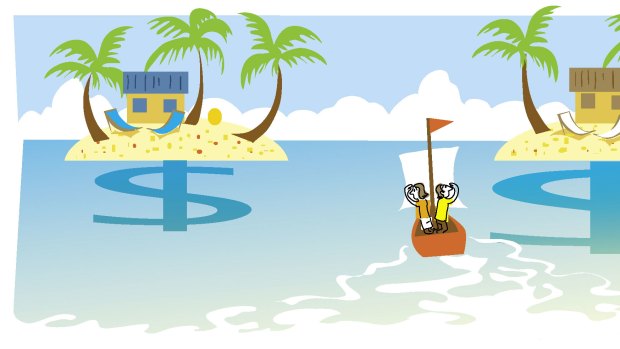By Jane E. Fraser

Illustration: Michael Mucci.
If you're not sure whether an all-inclusive deal is genuine value for money, it's worth doing the sums. The results might surprise you.
I LOVE the idea of all-inclusive resorts, where you turn up knowing everything is paid for. But I often wonder about their actual value versus their perceived value, when it is a case of one price fits all.
As a modest eater, am I subsidising the people heading back to the buffet for the fourth time? And as a modest drinker (most of the time!), am I paying for those who are still throwing back drinks when the bar shuts?
Would some of us be better off staying in a similar-standard resort and paying for what we consume as we go, especially when there are so many good accommodation deals in the market?
I hunted around the internet and looked at offers to attempt a comparison between all-inclusive and standard resorts and came up with some interesting results.
Club Med, the undisputed leader in all-inclusive holidays in this part of the world, had a 50-per-cent-off special for its Lindeman Island property in the Whitsundays, bringing the price for two people down to a starting level of $1368 for four nights, or $342 a night (some deals quoted in this article might no longer be available).
This included accommodation, meals, snacks, drinks and activities, so you wouldn't need to spend another dollar once you've arrived.
Compare this with nearby Daydream Island, which had a "pay three, stay four" offer on accommodation, which included breakfast and many activities.
The price for four nights at Daydream was from $898 for two people, which would leave $117.50 a day for meals and drinks if compared with the pricing for the Club Med offer.
Given two people would be very unlikely to get lunch, dinner and drinks for $117.50 a day in a 4½-star resort, Club Med was the clear winner for value.
However, if you take the special offers out of the picture and compare a standard four nights at Club Med with a standard four nights at Daydream, the prices would be something like $2736 versus $1196 - a difference of $1540.
Using pricing from Daydream's various restaurants, I calculated that a couple might spend about $850 on meals and drinks during a four-night stay, leaving them almost $700 better off than if they stayed at Club Med.
Another Queensland island resort that includes meals - but not drinks - is Heron Island, which had a four-night special from $1596 for two people. Compare this with Daydream's $898 for two, plus an estimated $500 for lunches and dinners, and you would again be better off at Daydream, although the difference is modest.
Of course, the comparisons are not that simple.
It depends on your spending habits, how the various resorts stack up in terms of standards and facilities and, importantly, the way you think about money. If you place a lot of value on having everything prepaid and not having to worry about how much you're spending while you're away, then you will naturally lean towards an all-inclusive resort.
If you tend to go overboard with holiday spending and come home to a big credit card bill, the peace of mind provided by an all-inclusive package could be hard to beat.
If you do want to do the sums, you need to work out the cost each night of comparable accommodation and see how much is left over.
Consider how much you are likely to eat and drink and what facilities you will use because there's no point paying for state-of-the-art sporting facilities if you plan to sit by the pool with a book.
Another thing to look at is the cost of travel and transfers because what you save in spending money can be chewed up easily by expensive transfers or flying on a route that rarely has cheap seats.
An alternative to the all-inclusive concept is to look for a package with some meals and activities included.
Many resorts will throw in breakfast if you ask and plenty offer kids-eat-free deals, which can make a big difference for families.
There is no definitive formula that is going to work for every traveller but it certainly pays to do the maths, so you can weigh up the actual value with your ideas about how you like to spend your holidays.
The upper end
All-inclusive resorts are thin on the ground in Australia but much more common in other parts of the world. Destinations such as Mexico and the Caribbean have a good range from which to choose, with options including adults-only resorts and family-oriented properties. All-inclusive resorts tend to be at the upper end of the accommodation scale but there are some cheaper options if you hunt around. If you have a spare $8000, you can book Sir Richard Branson's new Noosa retreat, Makepeace Island, for a night, though you'll still have to pay for your drinks.
Sign up for the Traveller newsletter
The latest travel news, tips and inspiration delivered to your inbox. Sign up now.